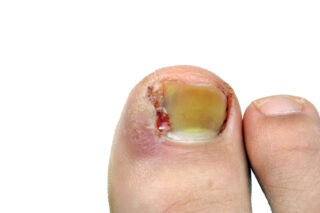
Arlington Podiatry Center
611 South Carlin Springs Road
Suite #512
Arlington, VA 22204

More Podiatry Foot Care Articles
Common Nail Disorders

Ingrown Nails
An ingrown nail is the result of a nail growing into the skin that surrounds it, and often occurs at either edge of the big toe. Improper trimming, inherited nail deformities, injuries, fungal infections, or pressure may cause ingrown nails.
The main symptom is pain at the tip of the toe. An ingrown nail can possibly lead to infection, inflammation, or a more serious condition. It is advisable to see a podiatrist who can determine the extent of your problem.
The podiatrist will examine the infected area, and will take blood tests, cultures, or x-rays if a more severe problem is suspected.
If the nail isn’t infected, your podiatrist may trim the corner of it to help relieve your symptoms. He or she may need to remove one side of your nail back to the cuticle. The base of the nail is then treated to keep the ingrown part from growing back.
Severe infections or ingrown nails may require antibiotics and removal of a portion of the nail.
Thickened Nails
Abnormally thick or crumbling nails may be caused by injuries, pressure from shoes, fungal infections, or conditions such as diabetes, psoriasis, or vascular disease.
A thickening nail may appear ridged, brittle, or yellowish, and may even cause pain when pressure is applied to it. This type of nail disorder may be a symptom of an underlying medical condition.
If the nail is not infected, your podiatrist can thin the nail.
If a fungal infection is present, oral or topical anti-fungal medications may be needed.
Black-and-Blue Nails
A black-and-blue nail is usually caused by sudden or repetitive injury to a toe.
Bruised, broken blood vessels cause the black-and-blue colors under the nail. If the condition is the result of a sudden injury, pain may be severe and an evaluation of your entire foot should be done.
If pain is severe, the nail may be removed or a hole may be drilled in the nail to allow drainage, which relieves the pressure. Pain may also be relieved with medications, or by soaking or icing the area. If pain is not severe, you may not need treatment.
Prevention of Nail Problems
Wearing the right shoes and trimming your nails properly can prevent many nail problems. Wear shoes that are supportive, roomy, and made of natural materials such as leather, which allow your feet to breathe.
Trim your nails straight across without cutting down into the corners. To help avoid infection, keep your feet clean and dry.


















